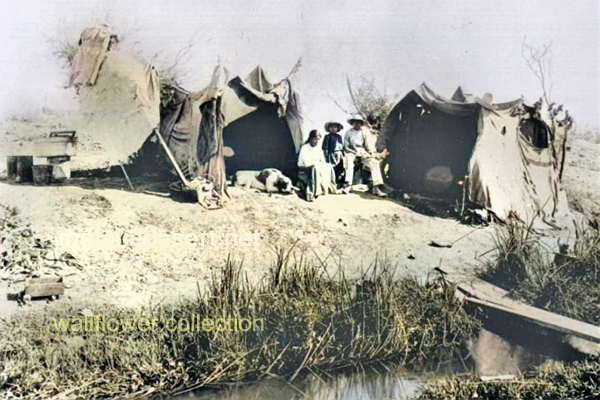--
Las Vegas Springs

Las Vegas Springs 1907 (colorized)
Bubbling artesian springs flowed here until they were exhausted in the middle of the 20th century, over-pumped to serve the city's growing population.
Las Vegas Springs and the Old Spanish Trail are both historical features associated with the region around Las Vegas, Nevada.
Las Vegas Springs:
Las Vegas Springs refers to a series of natural springs that were once a vital water source in the Las Vegas Valley. The springs were originally used by Native American populations in the area, such as the Southern Paiute people. In the 19th century, as European-American settlers began to arrive in the region, the springs became an important stopping point for travelers on the Old Spanish Trail.Old Spanish Trail:

The Old Spanish Trail was a historic trade route that connected Santa Fe, New Mexico, with Los Angeles, California. It was established in the early 19th century and was used primarily for the trading of goods, including furs, between the Mexican provinces of Santa Fe and California. The trail passed through various landscapes, including deserts and mountain ranges. Las Vegas Springs served as a watering point along the Old Spanish Trail, providing a critical resource for travelers and their animals.
Both Las Vegas Springs and the Old Spanish Trail played significant roles in the history of the American Southwest, serving as important waypoints for indigenous peoples, explorers, and traders. Today, Las Vegas is a thriving city, and while the natural springs are not as prominent as they once were due to urban development, their historical significance is still recognized. The Old Spanish Trail, with its connections to trade and exploration, is a testament to the rich history of the region.
Las Vegas Valley Paiute

Regarding Las Vegas Springs
The Pioneer Trail celebrates the early history of Las Vegas, offering a glimpse of the people and places that made Las Vegas thrive.These springs and the creek they created gave life to the center of the valley. They erupted about 8000 years B.P. (before present). People came to the valley because of the reliable water and the plants and animals it supported. The springs allowed the Anasazi Indians and later the Paiute Indians to irrigate small gardens. Between 1829 and 1848, the natural grasslands watered by the creek made this an important stop for New Mexican mule caravans on their way to California. These Spanish-speaking traders named the campsite "Las Vegas" (the meadows).
Anglos began using the water in 1855, when the Mormons opened a mission about three miles east of the Springs. Later, pioneers John Howell and James B. Wilson developed a ranch at the Springs site. Howell was the first black man to settle in Las Vegas Valley. He arrived in 1870, married a Paiute woman and ran cattle with Wilson from 1872-1874, when Wilson left the valley. In 1876, Howell sold his "Spring Ranch." In 1902, the springs, creek and land were sold to the San Pedro, Los Angeles and Salt Lake Railroad, which discontinued ranching at the springs so the water could be used to serve Las Vegas.
From the Pioneer Trail Brochure:
Much of the original historical facilities remain intact, and the site is now a cultural center with interpretive and educational exhibits. Portions of the Springs site are listed on the State and National Register of Historic Places.
HISTORICAL MARKER DATABASE
https://www.hmdb.org/m.asp?m=51043
retrieved 04/30/2022